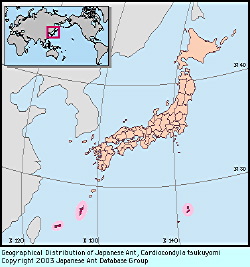
|
species
|
Cardiocondyla tsukuyomi
|
 |
Japanese Name
|
Hime-hadaka-ari
|
Original Reference
|
|
Terayama, M., (1999) Taxonomic studies of the Japanese Formicidae, Part 6. Genus Cardiocondyla Emery. Memoirs of the Myrmecological Society of Japan 1: 99-107.
|
Description
|
|
Total length of workers around 2 mm. Body color blackish brown to black. Closely similar to C. nuda. The worker petiolar node tends to be much narrower anterodorsally than in that species, but this character is not always dependable.
|
Remarks
|
|
C. kagutuchi and C. nuda are so similar that their tmorphological descriptions given here are almost identical. However, C. kagutuchi has 27 chromosomes, while C. nuda has 28 (Imai & Yamauchi, unpublished). Also, the male caste system of C. kagutuchi differs from that of C. nuda. The former is dimorphic, and has both alate and ergatoid males. , while C. nuda is believed to have only ergatoid males.
|
|

Distribution
|
|
Nansei Is, Daito Is, Senkaku Is, Ogasawara Is.
|
|
References
|
|
- Terayama, M. (1999). Taxonomic studies of the Japanese Formicidae, Part 6. Genus Cardiocondyla Emery. Memoirs of the Myrmecological Society of Japan 1: 99-107.
- Yamauchi, K. & K. Kinomura (1993). Lethal fighting and reproductive strategies of dimorphic males in Cardiocondyla ants (Hymenoptera: Formicidae). . In T. Inoue & Sk. Yamane, eds., ""Evolution of Insect Societies"", 373-402. .
|
Editor
|
|
Original text by Mamoru Terayama, Katsusuke Yamauchi and Masaaki Morisita. English translation by Mamoru Terayama, edited by Robert W. Taylor
|
|